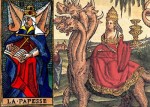 One of my favorite tales about the medieval Church tells of a woman who disguised herself as a man and rose through the ecclesiastical ranks to become Pope, only to be exposed when she gave birth in the middle of a public procession on the Via Sacra in Rome. How’s that for drama? In yo face, Yentl!1
One of my favorite tales about the medieval Church tells of a woman who disguised herself as a man and rose through the ecclesiastical ranks to become Pope, only to be exposed when she gave birth in the middle of a public procession on the Via Sacra in Rome. How’s that for drama? In yo face, Yentl!1
The Church of course denies this ever happened and consider it Protestant Reformation slander. Although the Protestants certainly jumped all over the story with enormous gusto, the earliest source long predates them. Dominican friar Jean de Mailly first mentioned a female Pope in his 1254 Chronica Universalis Mettensis. Set in 1099, this ladyPope story didn’t have the high drama of the Via Sacra birth, just that she dropped a baby while mounting a horse and was promptly tied to said horse and dragged to her death.
It wasn’t until Martin of Opava picked up the tale and ran with it in the third iteration of his 1278 Chronicon Pontificum et Imperatorum that we get the fully flushed public labor element and the name: Pope John, known as Joan once all is revealed. He also places the story earlier in the 9th century.
John Anglicus, born at Mainz, was Pope for two years, seven months and four days, and died in Rome, after which there was a vacancy in the Papacy of one month. It is claimed that this John was a woman, who as a girl had been led to Athens dressed in the clothes of a man by a certain lover of hers . There she became proficient in a diversity of branches of knowledge, until she had no equal, and afterwards in Rome, she taught the liberal arts and had great masters among her students and audience. A high opinion of her life and learning arose in the city, and she was chosen for Pope. While Pope, however, she became pregnant by her companion. Through ignorance of the exact time when the birth was expected, she was delivered of a child while in procession from St Peter’s to the Lateran, in a lane once named Via Sacra (the sacred way) but now known as the “shunned street” between the Colisseum and St Clement’s church. After her death, it is said she was buried in that same place. The Lord Pope always turns aside from the street and it is believed by many that this is done because of abhorrence of the event. Nor is she placed on the list of the Holy Pontiffs, both because of her female sex and on account of the foulness of the matter. (Martin of Opava, Chronicon Pontificum et Imperatorum)
Such juiciness would not be denied and authors from Vatican librarians to Giovanni Boccaccio wrote about her. Once the Reformation kicked in, the story was used as a convenient symbol of Church corruption and as evidence that the papacy wasn’t really necessary at all since Christendom survived the foulness of her lady parts smeared all over the throne of Peter.
The best title in this anti-Catholic vein was from a book published in England in 1675 by an anonymous author who the preface assures us was a most impeccable insider Vatican source. It’s called A Present for a Papist: Or the Life and Death of Pope Joan, Plainly Proving Out of the Printed Copies, and Manscriptes of Popish Writers and Others, That a Woman called JOAN, Was Really POPE of ROME, and Was There Deliver’d of a Bastard Son in the Open Street as She Went in Solemn Procession.
 And now, there’s a movie about her based on the biographical novel by Donna Woolfolk Cross. The Church is less than enthused about it, surprise, surprise, but it’s in the top 10 box office hits in Italy. (Italians love them a good historical Church scandal.) Pope Joan is played by Johanna Wokalek, a German actress I’m not familiar with, but John Goodman plays Pope Sergius and that just rules. Also, the cute guy who was Faramir in Lord of the Rings plays her boyfriend.
And now, there’s a movie about her based on the biographical novel by Donna Woolfolk Cross. The Church is less than enthused about it, surprise, surprise, but it’s in the top 10 box office hits in Italy. (Italians love them a good historical Church scandal.) Pope Joan is played by Johanna Wokalek, a German actress I’m not familiar with, but John Goodman plays Pope Sergius and that just rules. Also, the cute guy who was Faramir in Lord of the Rings plays her boyfriend.
IMDB tells me it was released in October 2009, but this is the first I’ve heard of it. I swear I will hunt down the sole dingy art movie house it’s playing in, so help me Joan.